Classification of Scleroderma
There are two types of scleroderma: localised scleroderma and systemic scleroderma.
Localised Scleroderma
Localised scleroderma does not impact on life expectancy, but it can affect the quality of life because of changes in the appearance of the skin, the restriction of movement, and though rare, it can cause deformities of the face and extremities.
There are four main types of localised scleroderma, each characterised by the amount of skin affected and the shape of the skin. Although usually, one type of localised scleroderma predominates, some people have a combination of localised scleroderma.
Morphea scleroderma
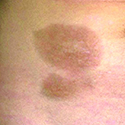
The most common of type of localised scleroderma, morphea scleroderma is where there is one or maybe three or four patches of skin thickening with different degrees of pigment changes, which means that some areas of the skin can be lighter or darker than the unaffected skin surrounding it. The patches start out red or purple and then turn whitish in the centre. This change does not cause any pain, but it can cause itching (pruritus).
Generalised morphea scleroderma
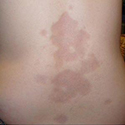
This involves larger areas of the skin surface being affected, though it is rare that the entire body is covered. Generalised morphea can affect the person’s appearance with the skin being different colours and because the skin thickening over the joints limits the range of movement.
En coup de sabre
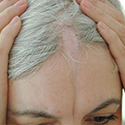
The rare, localised form of scleroderma occurs on the face or scalp and looks like a white line, which gives it the name (“en coup de sabre.” translates to “cut from a sword”). En coup de sabre can be very destructive, particularly when it causes loss of tissue in the face of children, as it can involve the tongue and mouth and though extremely rare, can cause abnormalities in the growth of facial bones, with the potential to cause considerable deformities.
Linear scleroderma
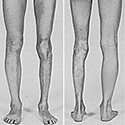
Linear scleroderma is where a band or line of skin becomes thickened. This can extend deep into the skin, into the underlying muscle. The thickened band of skin is usually found on the arms and legs, and if it passes over the joint, can affect normal joint movement.
Systemic Scleroderma
People with systemic scleroderma (also called systemic sclerosis) are divided into two sub-types depending on the extern of skin involvement. These subgroups are diffuse cutaneous scleroderma and limited cutaneous scleroderma.
Diffuse cutaneous scleroderma
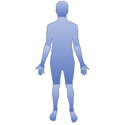
Those with diffuse cutaneous scleroderma have thick, tight skin on the arms and legs, both above and below the elbows and knees, but not always including the face. The skin on the chest and abdomen is usually also thick, tight or hard, with growth continuing from anything from one to three years before the skin begins to soften.
Diffuse scleroderma: This comes on quickly. The skin on the middle part of the body, thighs, upper arms, hands, and feet can become thick. This form also affects internal organs, like the heart, lungs, kidneys, and gastrointestinal tract.
Limited cutaneous scleroderma
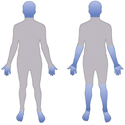
People with this form of the disease have thick, tight, or hard skin on the hands and feet with or without the involvement of the face, with the spread being very small and slow. It can also damage the lungs, intestines, or oesophagus and is sometimes referred to as CREST syndrome. The outlook is good, but the disease tends to get worse over time. Sometimes, it can affect the heart and raise blood pressure in the lungs, which can all be treated.
